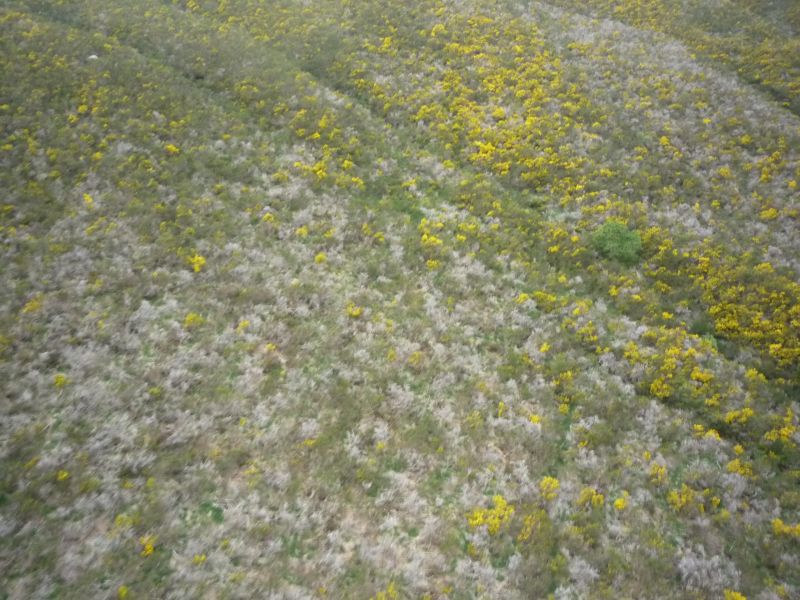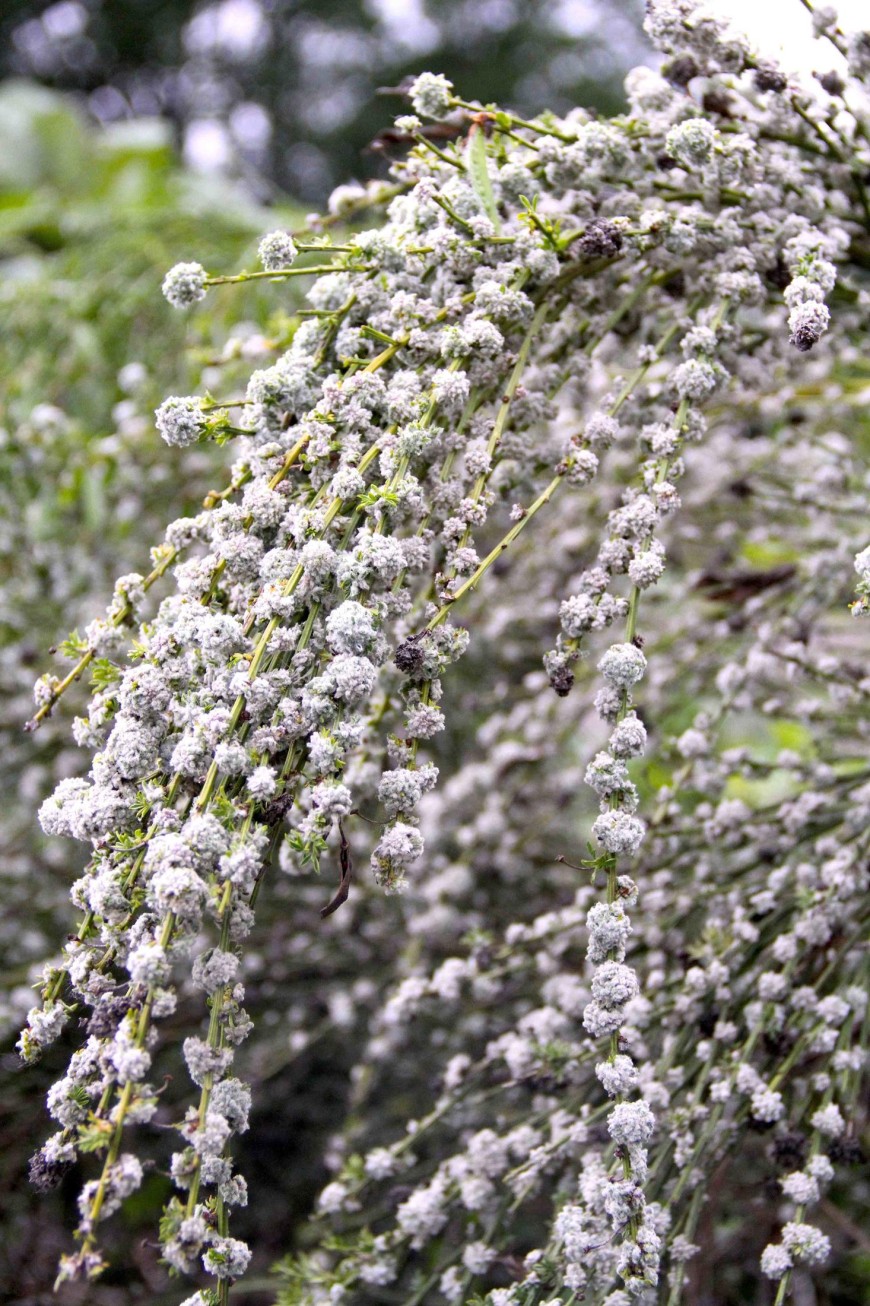Revisiting Broom Gall Mite Release Sites
Since the 1980s Manaaki Whenua – Landcare Research (MWLR), together with its stakeholders, has maintained a comprehensive database of release sites for weed biocontrol agents, particularly in the decade or so after their first release. The information stored in this database is not as high quality as we would gather for a flagship monitoring programme, but the size and geographical spread of the available data sets lend considerable statistical and interpretative power. We developed and refined this ‘release site reassessment’ method with the ragwort (Jacobaea vulgaris) and nodding thistle (Carduus nutans) biocontrol programmes, and recently applied it to the broom gall mite (Aceria genistae), the latest and probably most effective agent against Scotch broom (Cytisus scoparius).

Image: broom on hillside.
A suite of biocontrol agents has been released against Scotch broom in New Zealand, of which the most widespread and common species - both introduced in the 1990s - are the broom psyllid (Arytainilla spartiophila) and the broom seed beetle (Bruchidius villosus). In addition, the broom twig miner (Leucoptera spartifoliella) was a self-introduced agent, first detected in 1950, which causes considerable damage in some areas by attacking the stems.
The seed beetle is now destroying much of the seed produced annually. The psyllid damages new growth in spring and is becoming common, but very damaging outbreaks occur infrequently. The gall mite, released in 2008, has established widely in New Zealand and, particularly in the southern half of the South Island, has been observed causing high levels of damage and mortality in large stands of Scotch broom.

Image: Broom infested with broom gall mite
Gall mite release sites for reassessment in 2021/22 were identified from the MWLR biocontrol database and using local stakeholder knowledge. On each revisit a visual, but quantitative, assessment was made of the release site and immediate surroundings using a questionnaire form developed and improved with the ragwort and nodding thistle site reassessment projects. As with these studies, where possible a questionnaire interview was also carried out with the landowner or site manager. Although the survey focused on the gall mite, we scored both galls and the three widespread other broom agents.
Agent occurrence in the site reassessments
The data showed that most of the four broom agents are widespread across New Zealand wherever Scotch broom is prevalent. The broom gall mite was present at 74 of 130 sites (57%) revisited in the 2021/22 study. Assuming these mites all originated from the deliberate releases at the sites from 2009 to 2015, 57% could be considered a reasonable estimate of the establishment rate for broom gall mite releases. However, this figure is prey to a range of uncertainties, such as immigration of mites from other sites and the potential loss of established mite populations at some sites (e.g. if broom declined markedly).
Evidence for the impact of broom gall mite on broom
Encouragingly, there was a significant decline in the percentage cover of Scotch broom at broom gall mite release sites in this study. At or around the time of release the percentage cover of broom at the sites was 66.5%, and by 2021/22 it had declined to 44.4%. This decline in broom cover at agent release sites appears to be a promising sign of successful biocontrol, but the data are merely correlative: this is not an experimental study comparing release sites with appropriate non-release sites as controls.
However, we can look at the variation in abundance of the broom gall mite between sites to explore this pattern of reduced broom cover more closely. We might expect, for example, that broom cover would have declined more at sites where the broom gall mite was abundant (if abundance of the agent was causing the decline in cover of the weed), but it turns out this is not the case. An exploratory look at the data showed that the greatest reduction in broom density (from the time of release to the reassessment in 2021/22) occurred where broom gall mites were absent or rare. What might be going on to create this unexpected correlation?

Image: close up of broom galls.
Firstly, it seems highly unlikely from other observations of gall mites damaging Scotch broom that the agent is directly causing an increase in broom density at sites where the agent is common. We then investigated whether there were other control methods being applied at the sites, in particular herbicide applications. Fortunately, there were data from 35 sites on both the change in broom cover and on whether the site had recently been sprayed with herbicide. We found there was a significantly greater reduction in broom density at the 12 sites where herbicide was recorded as having been applied (41% reduction in broom cover) compared to the 23 unsprayed sites (7.9% reduction in broom cover). However, there remained the unexpected effect that there were greater declines in broom at sites where broom gall mites were less prevalent.
It is likely that recent spraying would cause a major decline in percentage cover of Scotch broom, after all, that’s why people spray. However, the smaller, but still statistically significant, effect of broom declines at sites with lower broom gall mite prevalence is harder to interpret. It certainly suggests that the current levels of galling are not having a rapid effect on the mortality of broom bushes, otherwise some effect of high prevalence of galling on reducing broom cover might be expected. It is possible that the broom gall mite does better at sites where there are higher levels of broom cover, and that we will not detect an effect of these higher gall mite prevalences without follow-up site visits to detect subsequent broom declines.
It is also possible that our data are recording only very recent use of other control methods against broom, so that we are missing earlier control. Earlier control using herbicides, that was not recorded in our site reassessments, might explain the large number of sites where broom abundance had declined markedly but there were zero or low numbers of galls. Scotch broom control using herbicides is likely to have a negative effect on the prevalence of broom gall mite. In extreme cases, if broom cover had been reduced to near zero by earlier, unrecorded, spraying, then current broom gall mite prevalence could be expected to be very low because its host plant is now rare at the site.
We then tested whether there is any evidence that spraying affects broom gall mite prevalence. We found that there is such an effect, with a mean prevalence of galls of 29.3% at unsprayed sites versus 16.7% at sprayed sites. This suggests that sprayed sites do have a lower prevalence of broom gall mite, which could mean herbicide spraying harms broom gall mites, directly or indirectly. Overall, recent use of herbicide to control Scotch broom was noted at almost a third (30%) of broom gall mite release sites.
There is some other positive evidence in these data on the potential impact of broom gall mite on broom. A significantly smaller proportion of Scotch broom plants appeared healthy at sites as the percentage of plants attacked by gall mites at the site increased.
The key take-home message is that the data are difficult to interpret, mainly because of the large proportion of broom gall mite release sites where herbicide has been used to control broom. Also, the weed density at or near the year of broom gall mite release was only recorded in 36 (26%) of sites, which compromised many of the analyses through absence of back-point comparison. Broom may also be a challenging weed to target with the site reassessment method because it invades a wide range of habitat types and, in some of these habitats, natural vegetation succession may tend to reduce broom cover over 10-20 years regardless of agent impacts.
Two obvious recommendations for the future are to try to select release sites that are unlikely to have been subjected to other control efforts against broom, and to ensure that a pre-release assessment of weed density is made. The latter could even be obtained retrospectively, provided good quality-photos were taken at sites at the time of release, particularly if these were taken from drones, allowing percentage cover to be reliably estimated from above. This technology was not widely available at the time the gall mite was released, but its time has come, and we could start using it now. For weeds invading multiple ecosystems, we may also need to investigate agent impact separately for each type of ecosystem under threat.
In conclusion, detailed impact studies over time are required to show subtle, but potentially beneficial, effects of weed biocontrol agents. Overall, a range of ecological studies suggest that Scotch broom is a promising target for suppression by biological control in New Zealand. However, the economically attractive release-site reassessment approach may not be the best option to assess the impacts of biocontrol for this particular weed.
This project was jointly funded by the National Biocontrol Collective and the Ministry for Primary Industries’ Sustainable Food and Fibre Futures Fund (Grant #20095) on multi-weed biocontrol.

